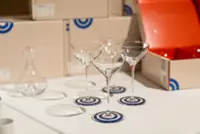Does the shape, taste and feel of a champagne glass affect how it tastes? The Mumm Taste Experience attempts to prove that it does. — Photo: Handout
Can the shape of a glass really change the taste and flavour of a champagne? Does the weight, look and feel of a glass influence the way your brain perceives the flavours of a wine?
That was the question posed to guests at the recent Mumm Taste Encounters event by champagne house G.H. Mumm recently.
Already a subscriber? Log in
Save 30% OFF The Star Digital Access
Cancel anytime. Ad-free. Unlimited access with perks.





